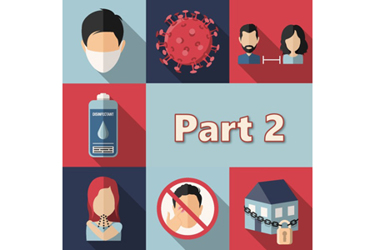The Long-Term Impact Of COVID-19 On Clinical Trials: Part 2
By James Gillespie, Ph.D., JD, MPA; John Whyte, MD, MPH; and Greg Licholai, MD, MBA

Missed Part 1? Start here to first learn about creating efficiencies in the R&D process, leveraging technology, building patient trust, and more.
The COVID-19 pandemic is helping create a “new normal” for the life sciences industry regarding the policies, procedures, and processes of clinical trials. This is accelerating the pace of change and fundamentally altering the interface of biopharmaceutical companies with patients, providers, regulators, and other key stakeholders. In continuing our analysis, we focus here on broader organizational and sector level dynamic such as competitor collaboration, globalization, industry goodwill, public health, supply chain, and workplace environment.
COVID’s Long-term Consequences On Clinical Trials: Industry and Organizations
We continue our examination of the 11 key potential long-term impacts of COVID-19 on clinical trials. In Part 1, we discussed five factors that more directly impact the clinical trial process and patients. In Part 2, we will discuss six factors that focus on organizational structure and the broader industry.
Changing Organizational Structures and The Workplace
Lessons learned during periods of substantial disruption can be used to improve best practices and establish new standard operating practices. Pairing the global orientation of the biopharmaceutical industry with the global impact of the coronavirus is a prescription for profound operational and strategic change. COVID-19 is a vivid reinforcement of the enduring value of business agility and adaptation, with the most resilient organizations at an advantage. The COVID-19 pandemic will focus more attention on both change management and contingency planning, and there is likely to be a greater use of flexible organizational structures and dynamic teams with shifting memberships. There will be a movement from relatively permanent teams working in one place within static organization structures to dynamic teams with shifting membership working from different locations within flexible organization structures.
Because it can reduce overhead for companies and because many people prefer the flexibility, the work-from-home movement was trending even before COVID-19, with many U.S. employees working remotely at least some of the time COVID-19 has separated us physically from family, friends, and colleagues. Messaging platforms are increasingly used. Video-teleconferencing traffic has increased significantly globally since the outbreak.1 There will be growth in automation of decisions, processes, and services, as well as virtualization activities, events, and interactions. There is likely to be a decreasing cost of distance as leaders, managers, and employees become more accustomed emotionally/psychologically and more facile logistically/operationally working from home. Given normal human inertia, the habits forming now will probably persist for many individuals and organizations. The new model will be physically distant, but socially close and emotionally closer.
Prompting Pre-Competitive Collaboration
The fight against COVID-19 is driving more digital, open-source collaboration. For example, a leading group of archivists created an open-access directory of more than 5,000 scientific studies about coronavirus that is freely accessible online. This has extended to the sharing of proprietary compound libraries.2 There will likely be more and more pressure to create researcher and public access to all the results of clinical trials.
Organized as working groups, the R&D heads of approximately a dozen biopharmaceutical companies met multiple times per week to coordinate the industry’s research and scientific response to COVID-19. They focused on clinical-phase repurposing, novel antibodies, novel small molecule antivirals, preclinical repurposing, and preventive vaccines. Biopharmaceutical companies also coordinated with governmental entities (e.g., FDA) and non-governmental organizations (e.g., Bill and Melinda Gates Foundation) in an effort to expand COVID-19 testing capabilities, screen global libraries of compounds and medicines to explore potential treatments, create new therapies for curing those infected, and develop vaccinations preventing future infections. Notably, there were increased private-public sector partnerships to continue the fight against COVID-19, to become better prepared for future pandemics, and to rebuild the world economy.
Embracing The Goodwill Dividend
Historically, across many surveys, the healthcare industry has recorded uneven levels of consumer trust. The pharmaceutical industry in particular sometimes has received less than fully favorable scores from the general populace. However, one positive by-product of COVID-19 is that there has been a rekindled admiration for frontline healthcare providers such as physicians, nurses, and paramedics, as well as a renewed appreciation for medicine and science. Health insurance companies have been lauded for promoting the use of telehealth, waiving co-pays and deductibles for certain periods, and covering many COVID-19 related procedures like diagnostic tests.
For the biopharmaceutical industry as a whole, the COVID-19 crisis provides a rare (perhaps once in 100 years?) and a massive opportunity to improve its image with the global public. In the U.S., for example, the industry has suffered from brand-tarnishing scandals related to (i) drug prices perceived as excessively high, (ii) the opioid crisis, and (iii) allegations of generic-drug price-fixing. These hot topics have attracted the ire of consumers/patients and the scrutiny of legislators/regulators. Regardless of the merits of these charges or the idiosyncrasies attributable to individual cases and specific companies, the entire industry unfortunately gets painted with a broad brush. Because of its continuing good work during the COVID-19 crisis, as well as the centrality of diagnostics and drugs to fighting the disease, the biopharmaceutical industry will have a goodwill dividend with the public and with policymakers. Like most dividends of this type, the reputational goodwill is fleeting (i.e., “use it or lose it”). The pharmaceutical industry has a great opportunity to argue for real change in the regulatory framework for conducting clinical trials, and it has a tremendous — but fleeting — opening to accomplish image rehabilitation and substantial rebranding.
Putting An Emphases On Public Health
Governments and the private sector will place increased focus on improving our community and public health systems. In the wake of COVID-19, governments are more likely to spend considerably more on preventative healthcare to try and avoid or at least minimize the massive costs associated with pandemics. This will include greater inter-governmental cooperation on joint research, sharing data, and uniform public communications. Pharmaceutical companies will continue to focus on indications such as diabetes and oncology that are both profitable and widespread. In the immediate wake of the initial COVID-19 crisis, the time was apt for pharmaceutical companies to join government-NGO-private initiatives in public health for areas such as anti-microbial resistance, neglected/rare diseases, and vaccine development. Government will need to do its part by providing proper incentive structures. COVID-19 tragically revealed glaring gaps in the public health systems of many nations, including the United States. To address this, there will need to be a primary care driven emphasis on population health that aims to enhance community health structures and patient-centric care management, while leveraging data in a scalable manner. The global pharmaceutical industry has a key role to play in helping address these medical needs across the care continuum and across disparate patient populations.
Shoring Up The Supply Chain
In recent decades, supply chains have been structured as massive, integrated, global networks featuring emerging economies, long-term contracts, and outsourced manufacturing. However, COVID-19 is presenting challenges to this operating model. Novel coronavirus has accented the need for the biopharmaceutical industry to develop novel ways to support supply chain management. We may need to rethink the patterns of global supply chains, including less offshoring and transiting to more distributed manufacturing models. There is likely to be even greater emphasize on attaining end to end digitalized supply chain with complete visibility across processes, products, and inventories. With a shift to more e-commerce, companies will focus more heavily on end-to-end supply chain management. There also will likely be greater use of micro supply chains which are characterized by decentralization (more numerous but smaller sources of production), localization (manufacturing closer to the point of sale), agility (being able to introduce new products on relatively quickly), and flexibility (shorter term contracts). To the maximum extent possible, micro supply chains aim to move value generation close to the customer, so they are less susceptible to risk factors such as exchange rates, regime change, and trade tariffs/quotas.
More — And Less — Globalization
Paradoxically, COVID-19 is likely to simultaneously make the world more and less globalized. More, because it vividly demonstrates the interconnectedness of the world — not just with regard to the obvious spread of the virus but in terms of the global response. Countries minimally affected by COVID-19 are generously sending equipment and supplies to countries heavily impacted. Doctors, nurses, and other healthcare professionals are traveling to help those in need, irrespective of borders, as human caring and professional duty take primacy. Companies and scientists are entering into multiple transnational research collaborations to discover diagnostics, vaccinations, and cures. An overriding ethos is that we are all citizens of the planet earth and have to unite against a common foe that does not recognize nationality or geographic boundaries. At the same time, COVID-19 has reinforced for some the potential health dangers of high international interconnectedness. As borders physically closed, international trade decreased, and travelers returned to their home countries, the world quickly and dramatically became less global. As the COVID-19 crisis eases, most of the international flows of people, products, and services will return, but certain trends (e.g., the reshoring of some biopharmaceutical and device manufacturing back to the US) may continue. There is likely to be a residual effect that could rapidly reemerge in the event of another global pandemic. It is unclear what, if any, long-term impact these countertrends (globalism vs. nationalism) will have on the clinical trial sector.
Four Final Thoughts On COVID-19’s Long-term Impact
We leave with four key takeaways. First, sunk-cost fallacies often inhibit change, so COVID-19 is as close as the industry will likely come to being able to ask, “What would it look like if we started all over?” and act on the answer(s). This is an opportunity to strive for something greater and more optimal. We need to rethink priorities and reorient strategies. Resources should be redeployed in accordance with the changed reality. The industry might consider creating a multi-disciplinary task force with representative drawn from key segments of the life science ecosystem, including patients and patient advocacy groups, to develop an action plan for R&D and clinical trials in this new environment.
Second, the industry should continue pre-competitive collaboration to address common areas of concern for the betterment of overall public health. Third, the industry should double down on key innovations such as digital technology, remote patient monitoring, telemedicine, and virtual clinical trials. Fourth, during this time of crisis, it is essential to continue building trust and maintain open lines of communication with key healthcare professionals such as hospital executives, principal investigators, trial coordinators, and patients. Working together, there is an opportunity to leverage COVID-19 in a way that ultimately benefits patients and the clinical trial process.
Resources:
- https://wdr2021.worldbank.org/spotlights/how-covid-19-increased-data-consumption-and-highlighted-the-digital-divide/
- https://libgen.me/about
About The Authors:
 James Gillespie, Ph.D., JD, MPA is an entrepreneur, executive, and researcher with expertise in the healthcare, life sciences, and technology sectors and extensive experience building collaborative stakeholder relationships across private, public, and NGO ecosystems. He is a research affiliate at the Yale School of Medicine’s Center for Digital Health Innovation, which develops, studies, and promotes digital innovations to improve lives and health, and he is an executive director at Sterling Bay, an innovative real estate development and investment firm. His education includes a Northwestern University Ph.D., Harvard University JD, and Princeton University MPA.
James Gillespie, Ph.D., JD, MPA is an entrepreneur, executive, and researcher with expertise in the healthcare, life sciences, and technology sectors and extensive experience building collaborative stakeholder relationships across private, public, and NGO ecosystems. He is a research affiliate at the Yale School of Medicine’s Center for Digital Health Innovation, which develops, studies, and promotes digital innovations to improve lives and health, and he is an executive director at Sterling Bay, an innovative real estate development and investment firm. His education includes a Northwestern University Ph.D., Harvard University JD, and Princeton University MPA.
 John Whyte, MD, MPH is a physician and author with a unique combination of government and private sector work that provides him with an exceptional perspective on wellness, clinical trials, information technology, innovation, and healthcare services. He has been a leading voice in addressing the COVID pandemic, being named as one of the top 20 health influencers. Dr. Whyte is also a major contributor to iterating digital platforms from simply providing content to playing a pivotal role in connecting to care. Dr. Whyte is a board-certified internist and continues to see patients. He completed an internal medicine residency at Duke University Medical Center as well as earned an MPH in health policy and management at Harvard University School of Public Health. Dr. Whyte was a health services research fellow at Stanford and attending physician in the Department of Medicine. He has written extensively in the medical and lay press, including numerous best-selling books.
John Whyte, MD, MPH is a physician and author with a unique combination of government and private sector work that provides him with an exceptional perspective on wellness, clinical trials, information technology, innovation, and healthcare services. He has been a leading voice in addressing the COVID pandemic, being named as one of the top 20 health influencers. Dr. Whyte is also a major contributor to iterating digital platforms from simply providing content to playing a pivotal role in connecting to care. Dr. Whyte is a board-certified internist and continues to see patients. He completed an internal medicine residency at Duke University Medical Center as well as earned an MPH in health policy and management at Harvard University School of Public Health. Dr. Whyte was a health services research fellow at Stanford and attending physician in the Department of Medicine. He has written extensively in the medical and lay press, including numerous best-selling books.
 Greg Licholai, MD, MBA is chief medical & innovation officer, and president of Symphony Health and Care Innovations at ICON plc. Dr. Licholai is on faculty of Yale School of Management, co-director of the Center for Digital Health, and teaches Innovating Healthcare at Harvard Business School. Previously, he was president of rare disease at Moderna Therapeutics and partner at McKinsey & Co. Dr. Licholai was educated at Harvard Business School, Yale School of Medicine, Columbia University, and Boston College. He trained in neurological surgery at the Brigham and Women's, Children's, and Massachusetts General hospitals. Dr. Licholai writes about innovation in healthcare for Forbes and his textbook Introduction to Medical Software: Foundations for Digital Health, Devices and Diagnostics is published by Cambridge University.
Greg Licholai, MD, MBA is chief medical & innovation officer, and president of Symphony Health and Care Innovations at ICON plc. Dr. Licholai is on faculty of Yale School of Management, co-director of the Center for Digital Health, and teaches Innovating Healthcare at Harvard Business School. Previously, he was president of rare disease at Moderna Therapeutics and partner at McKinsey & Co. Dr. Licholai was educated at Harvard Business School, Yale School of Medicine, Columbia University, and Boston College. He trained in neurological surgery at the Brigham and Women's, Children's, and Massachusetts General hospitals. Dr. Licholai writes about innovation in healthcare for Forbes and his textbook Introduction to Medical Software: Foundations for Digital Health, Devices and Diagnostics is published by Cambridge University.
